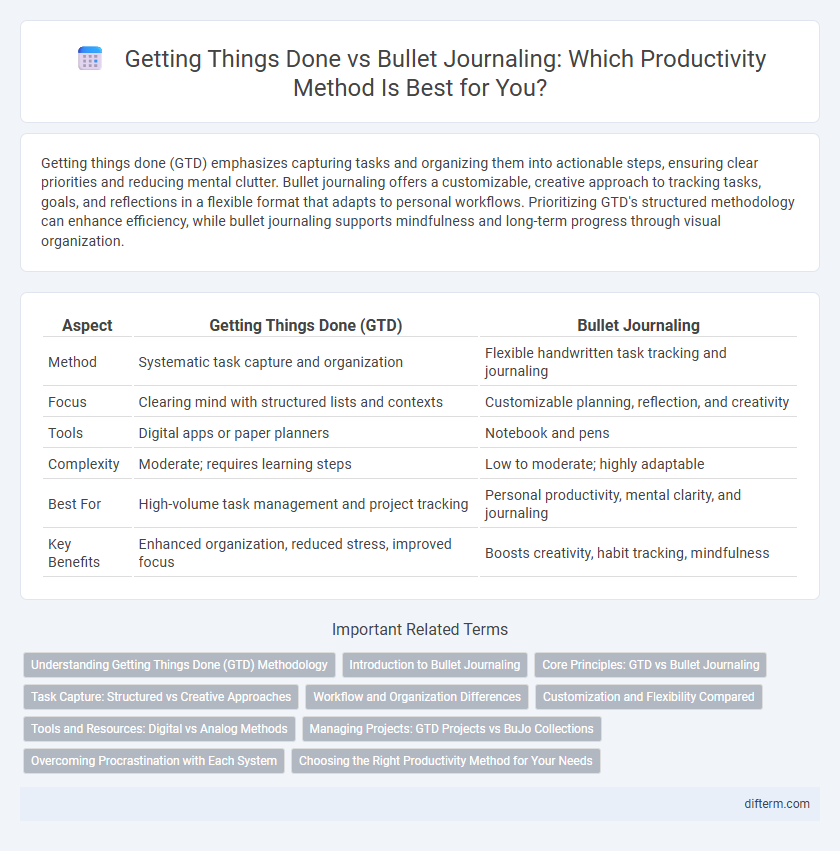Getting things done (GTD) emphasizes capturing tasks and organizing them into actionable steps, ensuring clear priorities and reducing mental clutter. Bullet journaling offers a customizable, creative approach to tracking tasks, goals, and reflections in a flexible format that adapts to personal workflows. Prioritizing GTD's structured methodology can enhance efficiency, while bullet journaling supports mindfulness and long-term progress through visual organization.
Table of Comparison
| Aspect | Getting Things Done (GTD) | Bullet Journaling |
|---|---|---|
| Method | Systematic task capture and organization | Flexible handwritten task tracking and journaling |
| Focus | Clearing mind with structured lists and contexts | Customizable planning, reflection, and creativity |
| Tools | Digital apps or paper planners | Notebook and pens |
| Complexity | Moderate; requires learning steps | Low to moderate; highly adaptable |
| Best For | High-volume task management and project tracking | Personal productivity, mental clarity, and journaling |
| Key Benefits | Enhanced organization, reduced stress, improved focus | Boosts creativity, habit tracking, mindfulness |
Understanding Getting Things Done (GTD) Methodology
The Getting Things Done (GTD) methodology, developed by David Allen, emphasizes capturing, clarifying, organizing, reflecting, and engaging with tasks to enhance productivity. Unlike bullet journaling, which relies on manual tracking and creative customization, GTD provides a systematic framework for managing commitments and reducing mental clutter. Implementation of GTD improves workflow efficiency by breaking projects into actionable steps and prioritizing tasks based on context and available resources.
Introduction to Bullet Journaling
Bullet journaling enhances productivity by combining task management, goal tracking, and creative expression in a single system. Unlike traditional to-do lists focused solely on getting things done, bullet journals organize tasks, events, and notes with customizable symbols, promoting mindfulness and adaptability. This method supports prioritization and reflection, helping users maintain focus and achieve long-term objectives effectively.
Core Principles: GTD vs Bullet Journaling
Getting Things Done (GTD) centers on capturing, clarifying, and organizing tasks into actionable steps to enhance execution and reduce cognitive load, while Bullet Journaling emphasizes rapid logging, reflection, and customization to boost mindfulness and adaptability. GTD relies heavily on predefined workflows and lists structured by context, project, and priority, promoting systematic productivity through consistent review cycles. Bullet Journaling prioritizes flexibility and creative input, allowing users to tailor their planning system with symbols and collections, fostering personal engagement and task tracking aligned with individual goals.
Task Capture: Structured vs Creative Approaches
Task capture in productivity balances structured methods like bullet journaling, which organizes tasks systematically with rapid logging and categorization, against creative approaches that encourage free-form note-taking to spark ideas and flexibility. Bullet journaling enhances clarity and prioritization through symbols and indexing, while creative task capture supports nonlinear thinking and adaptability in dynamic workflows. Choosing between these approaches depends on individual work styles and the nature of tasks, optimizing productivity by aligning capture techniques with cognitive preferences.
Workflow and Organization Differences
Getting things done (GTD) emphasizes capturing all tasks and projects in a trusted system, prioritizing actions based on context and defined outcomes to maintain a clear workflow. Bullet journaling combines task tracking with creative organization through rapid logging, signifiers, and monthly or custom collections, allowing for flexible adaptation of workflows. GTD focuses on systematic review and next actions lists for efficiency, while bullet journaling prioritizes visual organization and personalization to enhance engagement and memory retention.
Customization and Flexibility Compared
Getting things done (GTD) emphasizes a structured workflow system with clearly defined stages, optimizing task management through consistent reviews and context-based organization. Bullet journaling offers superior customization and flexibility, allowing users to tailor layouts, trackers, and notes to fit personal productivity needs and creative preferences. The adaptability of bullet journaling supports evolving goals, whereas GTD provides a rigid framework designed for efficiency and accountability.
Tools and Resources: Digital vs Analog Methods
Digital productivity tools like task management apps and calendar integrations streamline getting things done with automated reminders and real-time collaboration features. In contrast, bullet journaling leverages analog methods such as customizable layouts and hand-written notes to enhance focus and memory retention. Choosing between digital and analog resources depends on individual preferences for flexibility, tactile engagement, and integration with other productivity systems.
Managing Projects: GTD Projects vs BuJo Collections
Managing projects using GTD emphasizes clear, actionable outcomes with defined next steps for each project, ensuring consistent progress and completion. Bullet Journaling organizes projects into Collections, which serve as flexible, customizable hubs for tracking tasks, ideas, and resources related to specific themes. GTD projects provide structured task management for productivity clarity, while Bullet Journals offer creative adaptability for holistic project tracking.
Overcoming Procrastination with Each System
Getting things done (GTD) combats procrastination by breaking tasks into actionable steps with clear priorities, reducing overwhelm and increasing momentum. Bullet journaling leverages customizable lists and habit tracking to create a visual accountability system that reinforces daily focus and progress. Both systems enhance productivity by transforming intentions into structured routines that minimize decision fatigue and encourage consistent task completion.
Choosing the Right Productivity Method for Your Needs
Selecting the right productivity method depends on your workflow and personal preferences, with Getting Things Done (GTD) offering a structured, task-oriented system ideal for managing complex projects and deadlines. Bullet Journaling provides a flexible, customizable approach that integrates planning, reflection, and creativity for those who prefer visual organization and mindfulness. Evaluating your need for detailed task lists versus adaptable daily logs will guide you to a productivity method that enhances focus, efficiency, and goal achievement.
getting things done vs bullet journaling Infographic

 difterm.com
difterm.com